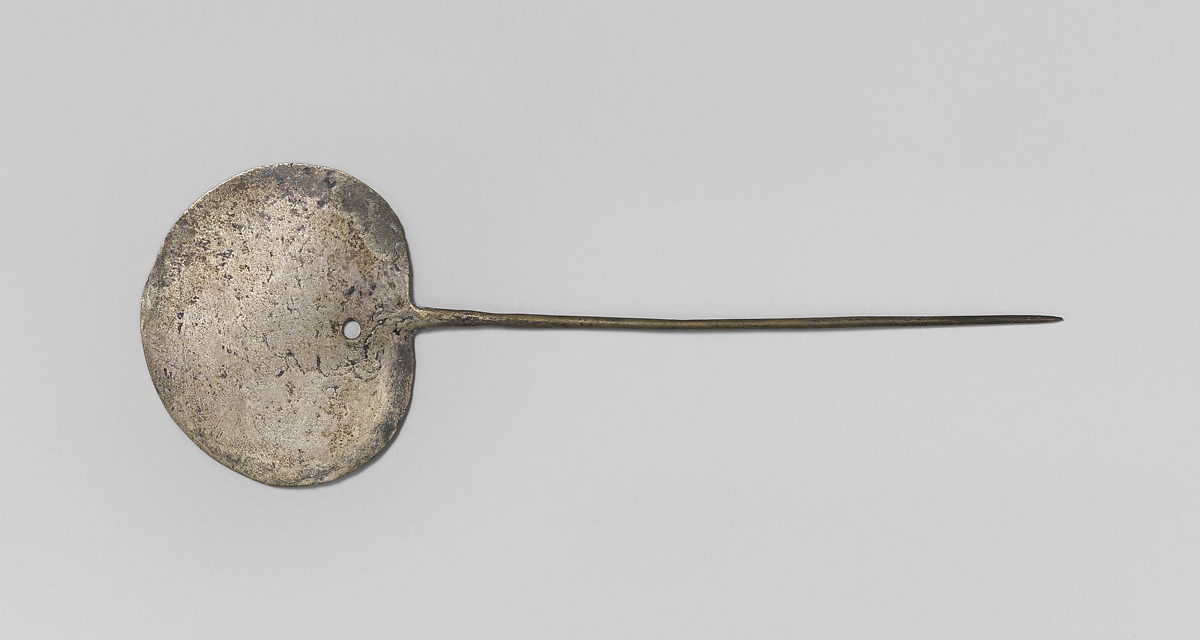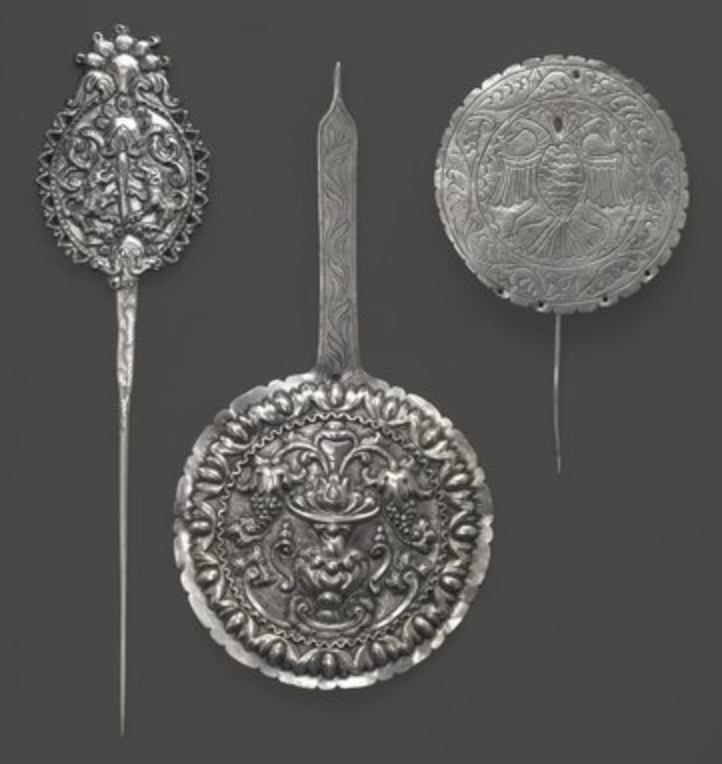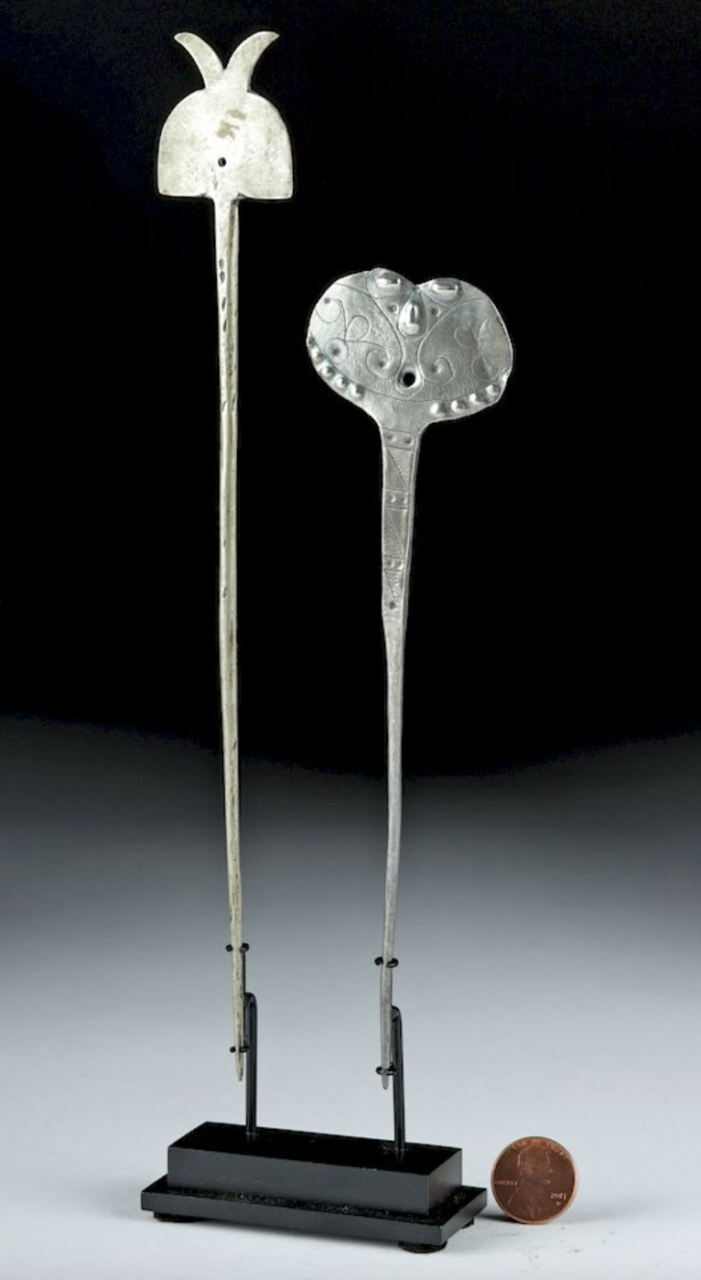A tupu is a long pin used to secure a garment worn across the shoulders. It was typically worn by Andean women in South America.
The Details
Fig. 1 - Maker unknown (South America). Tupu (pin), A.D. 1400-1533. Copper alloy; 29.2 x 7cm (h. 11 ½ x 2 ¾ in). New York: The Metropolitan Museum of Art, 64.228.701. Gift of Mr. and Mrs. Nathan Cummings, 1964. Source: The Met
Fig. 2 - Maker unknown (South America). Tupu (pin), Before 17th Century. Silver; 6.1 x 17.1 cm (w. 2 3/8 x l. 6 3/4 in). New York: The Metropolitan Museum of Art, 64.228.703. Gift of Mr. and Mrs. Nathan Cummings, 1964. Source: The Met
As Gordon Francis McEwan explains in The Incas: New Perspectives (2006), the tupu was a common Incan ornament worn as a shawl pin:
“The most common ornament was the tupu, or shawl pin, worn as a fastener for women’s clothing. The tupu was a straight pin with a broad spatulate head often pierced by a small hole, which allowed it to be attached to clothing by a thread to prevent its loss. The tupu was made of both gold and silver but most commonly of bronze.” (166)
The Met has a 15th-century copper tupu (Fig. 1) in their collection that features a symmetrical, nature-inspired design typical of the Inca. Flowers or butterflies were common motifs. Simpler designs were also frequently seen, as in a silver tupu with fewer decorative elements (Fig. 2) also in the Met’s collection; this was likely hammered out of a single piece of metal inclusive of the head and the stem.
Fashion historian Daniel Hill describes how tupu were used in The History of World Costume and Fashion (2011):
“the upper classes wore vicuna shawls, sometimes adorned with exotic, tropical plumage and affixed at the neck with a large gold or silver straight pin called a tupu.” (302)
Timothy Earle describes the value and prestige of silver tupu in the Bronze Age Economics: The First Political Economies (2018):
“Objects of silver for display, such as the tupu pins used to fasten a women’s shawl and pierced disks sewn onto clothing, were concentrated heavily in elite households in both period.” (273)
Tupus had widely different head sizes; a collection of Peruvian silver tupu pins (Fig. 3) from circa 700 to 1532 features slender stems and a rounded head design of various sizes.
Tupu pins were used to secure a mantle or shawl by Andean women. The Brooklyn Museum of Art has several silver tupu in their collection; one (Fig. 4) features a delicate floral design on the head of tupu, while another shows the engraved double-headed eagle of the Habsburg Empire surrounded by floral designs (far right in photo). From the silver material and ornate design, it is assumed that these tupu pins were worn by high-ranking women.
Fig. 3 - Maker unknown (Peru). Seven Peruvian Silver tupus, A.D. 700-1532. Silver; l 13.6 to 47cm (l 5 ⅜ to 18 ½ in). Source: Sotheby's
Fig. 4 - Maker unknown (Peru). Tupu (pin), 18th century. Silver alloy; 20.5 x 12.4cm (8 1/16 x 4 ⅞ in). New York: Brooklyn Museum, 41.1275.241. Source: Brooklyn Museum
Cecelia F. Klein, and Jeffrey Quilter describe the early usage (c. 200 BCE – 600 CE) and the value of tupu pins in the book Gender in Pre-Hispanic America: A Symposium at Dumbarton Oaks (2001):
“At Queyash Alto, women are identified unarguably by the recovery of tupu pins, metal (in this case copper) clothes fasteners that were widely used by Andean women and have been commonly recovered from archaeological sites… Copper was used extensively in the Peruvian Andes only beginning with the EIP [Early Intermediate Period], precisely when Queyash Alto was first occupied so that owning and displaying the new, technologically sophisticated copper tupus should be taken to indicate some sort of high status – or access to relatively rare prestige items – among Queyash Alto women…it can be argued that the tupu-wearing women were associated with an elevated kin group that was closely connected with the site, suggesting again that these artifacts belonged not to commoners but to elite women.” (23-24)
Fig. 5 - Maker unknown (Pre-Columbian, Tiwanaku). Tupu (Pin), 400 to 1100 CE. Silver; 22.5 x 3.3cm (h 8.85 x w 1.3 in). Source: bidsquare
Artemis Gallery describes a pair of Tiwanaku silver tupus (Fig. 5) auctioned in 2018:
“A pair of pretty hammered silver tupus, the ancient Andean version of a brooch or shawl pin. Each has a zoomorphic form. The taller one resembles the head of a bird with a crest or beak rising from the top. The shorter is more froglike, with swirling incised lines on the surface and stamped bulges forming eyes, nose, and a bubbled skin-like texture.”
While historic tupus are collected by museums and private collectors across the globe, today in Andean culture they tend to be worn only on special occasions or are used as decorative objects for the home.
References:
- Earle, Timothy. Bronze Age Economics: The First Political Economies. New York: Taylor & Francis, 2018. http://www.worldcat.org/oclc/1111772524
- Hill, Daniel Delis. History of World Costume and Fashion. Upper Saddle River, NJ: Pearson Prentice Hall, 2011. http://www.worldcat.org/oclc/768100950.
- Klein, Cecelia F., Quilter, Jeffrey. Gender in Pre-Hispanic America: A Symposium at Dumbarton Oaks, 12 and 13 October 1996. Washington: Dumbarton Oaks Research Library and Collection, 2001. http://www.worldcat.org/oclc/52523111
- McEwan, Gordon Francis. The Incas: New Perspectives. Santa Barbara: ABC-CLIO, 2006. http://www.worldcat.org/oclc/885426572















